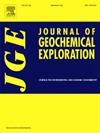中蒙边境地区流域沉积物中铅锌的特征及其与铅锌矿化的关系
IF 3.4
2区 地球科学
Q1 GEOCHEMISTRY & GEOPHYSICS
引用次数: 0
摘要
中蒙边境地区是中亚最重要的成矿带之一,是蒙古南部和中国北部金、银、铅、锌、锡、铜和稀有金属的重要产地。该地区铅、锌浓度的变化及其空间分布可间接反映该地区矿产资源的分布格局,为铅、锌相关元素(如金、银、铜、锰等)的勘探提供参考数据。此外,由于铅和锌是具有持久性和潜在毒性的重金属,其数据对环境研究也很有价值。尽管中国已开展了大量铅锌资源地质和地球化学调查,但对中蒙边境地区的研究仍然不足。因此,在本研究中,我们对单元素和组合铅锌地球化学异常进行了综合全面的分析研究。共采集了 10,452 个流域沉积物样本。样本中的铅浓度介于 1.90 至 494 毫克/千克之间,而锌浓度介于 3.00 至 1940 毫克/千克之间。其中,铅含量的中位数和平均值分别为每公斤 19.4 毫克和 55.0 毫克,锌含量的中位数和平均值分别为每公斤 19.9 毫克和 58.0 毫克。为了描述研究区域铅和锌的浓度和空间分布特征,我们从地质环境、矿产开发和利用等多个维度进行了详尽的研究,并探讨了影响这些特征的关键因素。本研究共确定了 53 个铅、锌地球化学异常(地球化学省/域,Pb > 23.1 mg/kg 和 Zn > 75 mg/kg,> Q85%),其中包括 17 个铅锌组合地球化学异常。铅锌组合地球化学异常主要集中在研究区西部的阿尔泰地区和东部的大兴安岭地区,与已知铅锌矿床的分布密切相关。本研究获得的高质量地球化学数据可为今后中蒙边境地区的矿产勘探工作和环境变化研究提供重要参考。本文章由计算机程序翻译,如有差异,请以英文原文为准。
Characterization of lead and zinc in catchment sediments and their relationship with lead‑zinc mineralization from the Sino–Mongolian border region
The Sino–Mongolian border region is one of the most important metallogenic belts in Central Asia and is an important source of Au, Ag, Pb, Zn, Sn, Cu, and rare metals in southern Mongolia and northern China. The variations in Pb and Zn concentrations and their spatial distribution in the region can indirectly reflect the distribution pattern of mineral resources in the region and provide reference data for the exploration of elements associated with Pb and Zn (e.g., Au, Ag, Cu, and Mn). Moreover, Pb and Zn data are valuable in environmental research because the elements are persistent and potentially toxic heavy metals. Although numerous geological and geochemical surveys of Pb![]() Zn resources have been conducted in China, the Sino–Mongolian border region remains under studied. Therefore, in this study, we performed an integrated and comprehensive analytical study of single-element and combined Pb
Zn resources have been conducted in China, the Sino–Mongolian border region remains under studied. Therefore, in this study, we performed an integrated and comprehensive analytical study of single-element and combined Pb![]() Zn geochemical anomalies. A total of 10,452 catchment sediment samples were collected. Pb concentrations in the samples ranged from 1.90 to 494 mg/kg, while Zn concentrations ranged from 3.00 to 1940 mg/kg. Of these, the median and mean values for Pb were 19.4 mg/kg and 55.0 mg/kg, respectively, while the median and mean values for Zn were 19.9 mg/kg and 58.0 mg/kg, respectively. To characterize the concentration and spatial distribution of Pb and Zn in the study area, we conducted an exhaustive study across several dimensions, considering the geological setting, mineral development, and utilization, and explored the key factors affecting these characteristics. A total of 53 Pb, Zn geochemical anomalies (geochemical province/domain, Pb > 23.1 mg/kg and Zn > 75 mg/kg, > Q85%), including 17 Pb
Zn geochemical anomalies. A total of 10,452 catchment sediment samples were collected. Pb concentrations in the samples ranged from 1.90 to 494 mg/kg, while Zn concentrations ranged from 3.00 to 1940 mg/kg. Of these, the median and mean values for Pb were 19.4 mg/kg and 55.0 mg/kg, respectively, while the median and mean values for Zn were 19.9 mg/kg and 58.0 mg/kg, respectively. To characterize the concentration and spatial distribution of Pb and Zn in the study area, we conducted an exhaustive study across several dimensions, considering the geological setting, mineral development, and utilization, and explored the key factors affecting these characteristics. A total of 53 Pb, Zn geochemical anomalies (geochemical province/domain, Pb > 23.1 mg/kg and Zn > 75 mg/kg, > Q85%), including 17 Pb![]() Zn combined geochemical anomalies, were identified in this study. The Pb
Zn combined geochemical anomalies, were identified in this study. The Pb![]() Zn combined geochemical anomalies were mainly concentrated in the Altai region in the west and the Daxinganling region in the east of the study area and are closely related to the distribution of known Pb
Zn combined geochemical anomalies were mainly concentrated in the Altai region in the west and the Daxinganling region in the east of the study area and are closely related to the distribution of known Pb![]() Zn deposits. The high-quality geochemical data produced during this study could be an important reference for future mineral exploration work and environmental change studies in the Sino–Mongolian border region.
Zn deposits. The high-quality geochemical data produced during this study could be an important reference for future mineral exploration work and environmental change studies in the Sino–Mongolian border region.
求助全文
通过发布文献求助,成功后即可免费获取论文全文。
去求助
来源期刊

Journal of Geochemical Exploration
地学-地球化学与地球物理
CiteScore
7.40
自引率
7.70%
发文量
148
审稿时长
8.1 months
期刊介绍:
Journal of Geochemical Exploration is mostly dedicated to publication of original studies in exploration and environmental geochemistry and related topics.
Contributions considered of prevalent interest for the journal include researches based on the application of innovative methods to:
define the genesis and the evolution of mineral deposits including transfer of elements in large-scale mineralized areas.
analyze complex systems at the boundaries between bio-geochemistry, metal transport and mineral accumulation.
evaluate effects of historical mining activities on the surface environment.
trace pollutant sources and define their fate and transport models in the near-surface and surface environments involving solid, fluid and aerial matrices.
assess and quantify natural and technogenic radioactivity in the environment.
determine geochemical anomalies and set baseline reference values using compositional data analysis, multivariate statistics and geo-spatial analysis.
assess the impacts of anthropogenic contamination on ecosystems and human health at local and regional scale to prioritize and classify risks through deterministic and stochastic approaches.
Papers dedicated to the presentation of newly developed methods in analytical geochemistry to be applied in the field or in laboratory are also within the topics of interest for the journal.
 求助内容:
求助内容: 应助结果提醒方式:
应助结果提醒方式:


